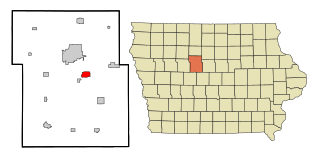
Carbon is a city in Douglas Township, Adams County, Iowa, United States. The population was 36 at the 2020 census.

Centerville is a city in and the county seat of Appanoose County, Iowa, United States. The population was 5,412 in the 2020 census, a decline from 5,924 in 2000. After the turn of the 20th century Centerville's coal mining industry attracted European immigrants from Sweden, Italy, Croatia, and Albania. Centerville is also home of the largest town square in the state of Iowa.

Cincinnati is a city in Appanoose County, Iowa, United States. The population was 290 in the 2020 census, a decline from 428 in 2000.

Exline is a city in Appanoose County, Iowa, United States. The population was 160 in the 2020 census, a decline from 191 in 2000.

Numa is a city in Appanoose County, Iowa, United States. The population was 68 in the 2020 census, a decline from 109 in 2000.

Rathbun is a city in Appanoose County, Iowa, United States. The population was 43 at the time of the 2020 census.

Colfax is a city in Jasper County, Iowa, United States. Colfax is located approximately 24 miles east of Des Moines. The town was founded in 1866, and was named after Schuyler Colfax, vice president under Ulysses S. Grant. The population was 2,255 at the time of the 2020 census. Newton is the county seat; both were named after Revolutionary War soldiers.

What Cheer is a city in Keokuk County, Iowa, United States. It is a former coal town, and from the 1870s to the early 1900s was one of the major coal-producing centers of Iowa. Its greatest recorded population was 3,246, in the 1890 census. The population was 607 in the 2020 census.

Lucas is a city in Lucas County, Iowa, United States. The population was 172 at the time of the 2020 census.

Beacon is a city in Mahaska County, Iowa, United States. The population was 445 at the 2020 census.

Oskaloosa is a city in, and the county seat of, Mahaska County, Iowa, United States. In the late nineteenth and early twentieth century, Oskaloosa was a national center of bituminous coal mining. The population was 11,558 in the 2020 U.S. Census, an increase from 10,938 in 2000.

Bussey is a city in southeast Marion County, Iowa, United States. The population was 387 at the time of the 2020 census.

Knoxville is a city in Marion County, Iowa, United States. The population was 7,595 at the time of the 2020 census, an increase from 7,313 in the 2010 census. It is the county seat of Marion County. Knoxville is home of the National Sprint Car Hall of Fame & Museum, located next to the famous Knoxville Raceway dirt track.

Marysville is a city in Marion County, Iowa, United States. The population was 44 at the time of the 2020 census.

Albia is a city in and the county seat of Monroe County, in southern Iowa, United States. The population was 3,721 at the 2020 census.

Lovilia is a city in Monroe County, Iowa, United States. The population was 472 at the time of the 2020 census.

Altoona is a city in Polk County, Iowa, United States, and is a part of the Des Moines metropolitan area. The population was 19,565 at the 2020 census.

Seymour is a city in Wayne County, Iowa, United States. The population was 634 at the time of the 2020 census.

Coalville is a census-designated place (CDP) in Webster County, Iowa, United States. The population was 610 at the 2010 census. The community is located on U.S. Route 20 near Fort Dodge's large gypsum mines.

Lehigh is a city in Webster County, Iowa, United States. The population was 395 at the time of the 2020 census.





















